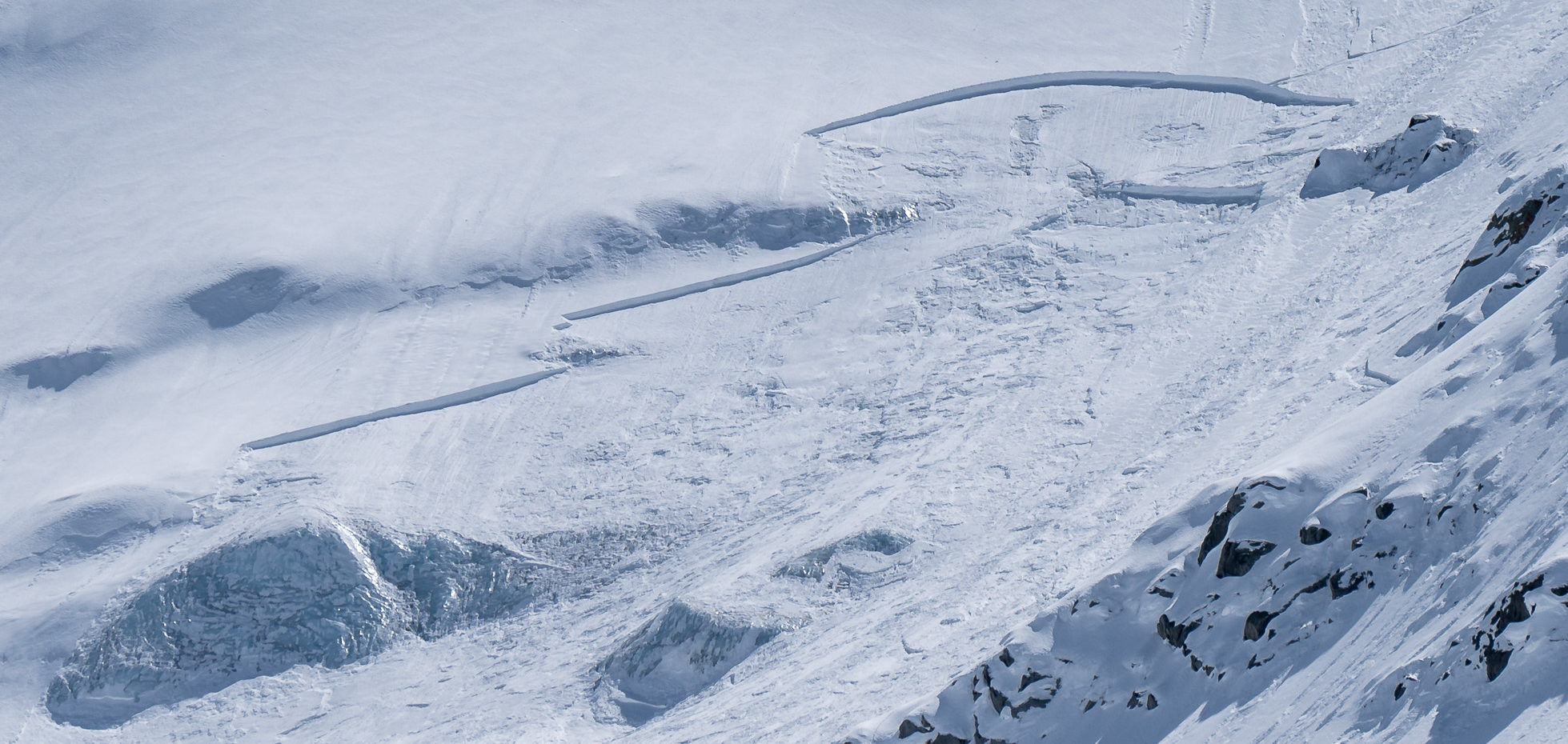P: Christian Riefenberg
The “5 Red Flags” is a system for detecting increased avalanche danger in the terrain that consists of 5 warning signs and is particularly popular in North America. Each of these warning signs points to a specific avalanche problem and proves existence in the field. The individual warning signs do not exclude each other and can overlap depending on the situation. Basically, these warning signs confirm the avalanche problems described in the avalanche report. These can also be present if no warning signs are detected in the terrain. Therefore, if a warning sign is recognized in the terrain, it only serves as a confirmation. If no warning signs can be seen, this does not necessarily mean that the avalanche problem indicated is not present – in most cases, the warning signs are simply overlooked.

Fresh snow
As accident statistics show, fresh snow always increases the risk of avalanches: 90% of all avalanches triggered by winter sports enthusiasts are triggered during or within 24 hours of a snowfall. The additional load of fresh snow can easily disturb existing weak layers and thus trigger slab avalanches. The missing bond between the individual crystals can result in loose snow avalanches, especially in steep terrain. A “fresh snow problem” exists during to several days after snowfall in all exposures and requires patience until the fresh snow has settled.

Wind
“The wind is the master builder of avalanches” – The wind displaces the falling or already fallen snow and creates drifted snow, which tends to break due to its higher strength. Cornices, wind vanes on ridges & peaks, as well as wind tangles on the snow surface are easily to recognize signs of strong wind. Drifted snow can develop very quickly and a drifted snow problem usually persists until a few days after the last wind impact. Danger areas are usually in depressions & gullies, behind terrain edges, and in wind calmed areas. Since drifted snow is usually easy to see, it can be bypassed fairly easily by winter sports enthusiasts. Drifting snow accumulations, as well as the transitions from much to little or soft to hard snow should be avoided.

Fresh avalanches
Spontaneous avalanches and deposits indicate high avalanche danger (level 3) for winter sports enthusiasts. Slopes with similar orientation, slope angle and elevation should be avoided. Terrain below gliding snow pillars should be avoided.

Rising temperature
Rapidly rising temperatures, e.g. due to daily warming or increased sunlight, can lead to a soaking of the snowpack and a rapid loss of stability. This issue is primarily limited by altitude and exposure. But beware: rain can also weaken the snowpack equally, so all exposures are affected.
To avoid this problem, there are the following possibilities, depending on the cause:
Solar radiation: stay on the shaded side
Rising temperature & rain: select higher areas if possible
In spring: start and finish the tour earlier
ATTENTION: Take lower approach routes and descents into account!

Cracks in the snowpack & settlement noises
Settlement sounds and visible cracks are a clear indication of weak layers in the snowpack, which are not visible from the outside. In contrast to new, drifted and wet snow, which can lead to spontaneous avalanches, an additional load such as a skier is required to trigger an avalanche in the case of an old snow problem. Weak layers can sometimes persist throughout the entire winter and can typically produce very large avalanches. Therefore, great reserve is required in the terrain and the danger areas identified in the avalanche report should be avoided. Particularly dangerous: Avalanches can also be triggered in flat slope areas, so steep terrain should be avoided WIDELY.
Want to know more? You can find more info about avalanche problems on the website of the Avalanche Warning Service Tyrol.
NOTE: This blog entry does not replace an avalanche course. The warning signs are sometimes difficult to recognize and require experience. #livetorideanotherday
Written By:
Nicolas Metz
CEO Delayon Eyewear & avalanche commissioner
Nico has always been drawn to the mountains and after years of experience in the sports industry, his geography studies in Innsbruck laid the foundation for a scientific understanding of snow. On this basis, he founded Delayon Eyewear in 2016. In 2018, the Hamburg native completed the avalanche commission's training by the State of Tyrol. Nico experienced the record winter of 2018/2019 with the Innsbruck Avalanche Commission on his local mountain, the Nordkette. Snow safety is a special concern for the passionate snowboarder. He passes on his knowledge and experience to students as a course instructor at the University of Innsbruck. His commitment became known through Instagram and various media appearances.












